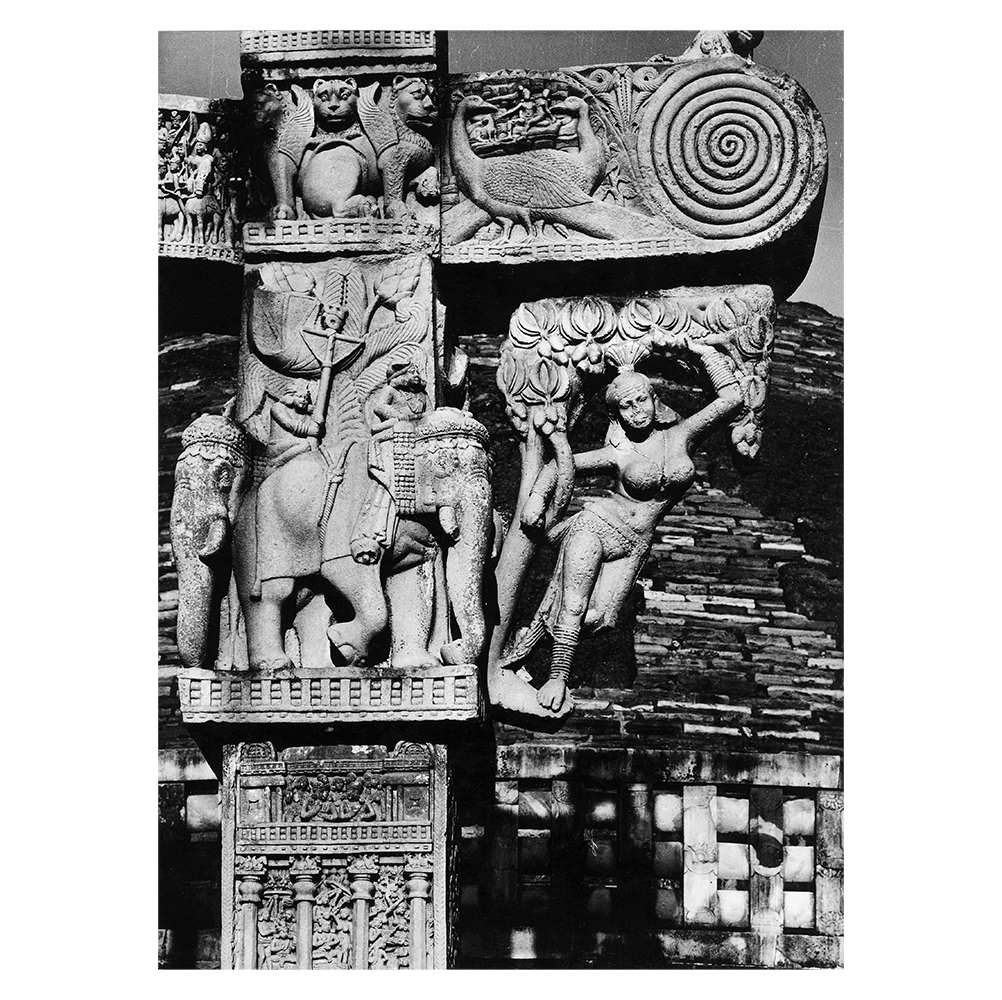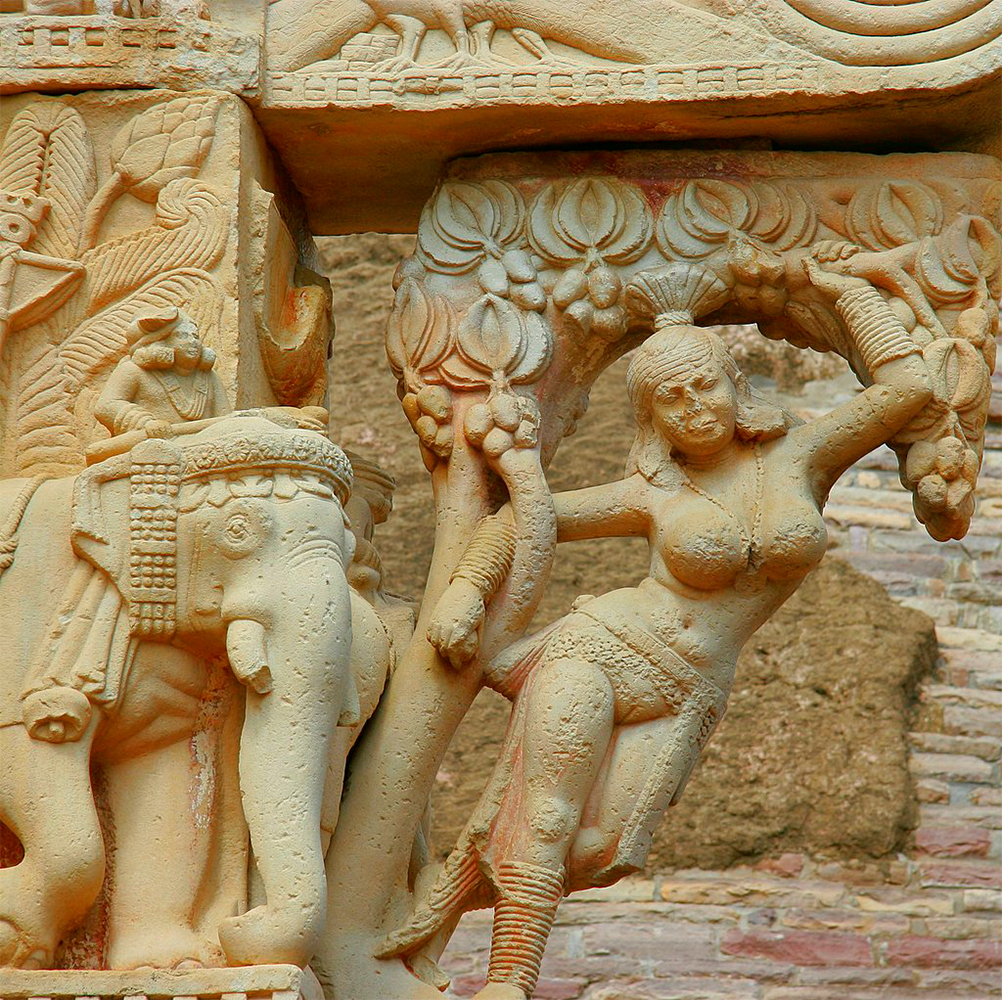ARTICLE
Yakshi, Eastern Gateway, Sanchi Stupa I
Standing in the tribhanga pose under a fruit-bearing tree, the Yakshi of the Eastern Gateway at Stupa I — also known as the Great Stupa, at Sanchi — is a sandstone figure on the bracket of the lower architrave of the gateway. The figure is roughly dated to the mid-first century BCE, when torana gateways were added to an older Mauryan period stupa believed to have been commissioned by the emperor Ashoka and housing the remains of the Buddha.
The Yakshi is naked save for a diaphanous lower garment held in place by a wide ornamental belt similar to those worn by pre-Mauryan fertility figures. She also wears a long necklace that falls between her breasts, along with several bangles and stacked anklets. Her hair is partly worn up in a coiffure. She is depicted clasping a branch with her left hand while her right hand is draped around what might be a vine or a branch. Her left leg is crossed behind the right and her foot rests on the tree trunk. These visual attributes qualify the figure as a shalabhanjika yakshi — a tree spirit associated with pre-Buddhist fertility cults in the subcontinent. Torana shalabhanjika figures are also found in art from this period, discovered at Mathura, Kaushambi and Kannauj.
Each of the four gateways at the Great Stupa originally had six shalabhanjika yakshis. Most of these yakshis have been damaged or removed from the site. All of them were similarly rendered, with voluptuous, partially nude and heavily ornamented bodies. There is also an appreciable degree of naturalism in the way the figures have been modelled compared to the Bharhut yakshis, which were carved a century before them. This also aligns the yakshis of the Sanchi gateways with their Mauryan counterparts.
Such sensuousness of form often led yakshi figures to be condemned as shameless depictions of female sexuality when they were first discovered by colonial surveyors in the nineteenth century. Contrarily, their sexual attributes were whitewashed by nationalist scholars, who were more concerned with building an evolutionary art history of Indian sculptural traditions based on the spiritual and metaphysical frame introduced by AK Coomaraswamy. According to this school of thought, yakshis are attendant or guardian figures, often depicted next to vegetal motifs or trees, which connect them to nature and fertility.
The shalabhanjika yakshi, in particular, is considered to embody fertility and productive power, able to coax a tree into blossoming or fruiting by a simple touch of her foot. Scholars suggest that as the image of such nude female figures developed over the years, they accumulated additional symbolic associations, transcending from the natural to the divine.
Whilst this yakshi remains attached to the gate at the stupa, similar shalabhanjika yakshis from the complex are held at the Los Angeles County Museum of Art, the British Museum, and other collections in India.
Bibliography
Ahuja, Naman P. Art and Archaeology of Ancient India: Earliest Times to the Sixth Century. United Kingdom: Ashmolean Museum, 2018.
Chandra, Pramod. The Sculpture of India, 3000 B.C.–1300 A.D. United Kingdom: National Gallery of Art, 1985.
Dayal, Deen. Eastern Gate of Sanchi Tope. Photographic print. British Library. Accessed February 15, 2023. https://www.bl.uk/onlinegallery/onlineex/apac/photocoll/e/019pho0000002s4u00003000.html#:~:text=The%20eastern%20gateway%20consists%20of,winged%20lions%2C%20peacocks%20and%20elephants.
Desai, Devangana. “Shalabhanjika: Woman-and-Tree in Art and Literature.” Prof. K. D. Bajpai Memorial Lecture, Kanyakumari, 2010. Accessed February 15, 2023. https://www.academia.edu/34913031/Shalabhanjika_Woman_and_Tree_in_Art_and_Literature.
“Great Stupa.” In Britannica. Accessed February 15, 2023. https://www.britannica.com/place/Great-Stupa-Buddhist-monument-Sanchi-India.
Unnikrishnan, Sandhya M. “Aestheticization of Yakshi Cult: Iconographic Representation of Yakshi Through Ages.” Journal of Multidisciplinary Studies in Archaeology 8, no. 2 (2020): 550–59.








